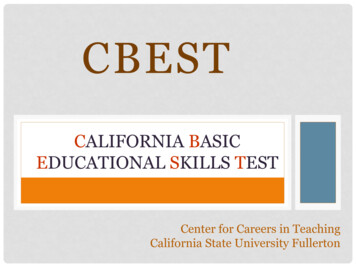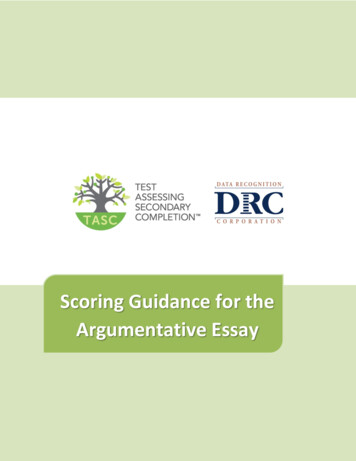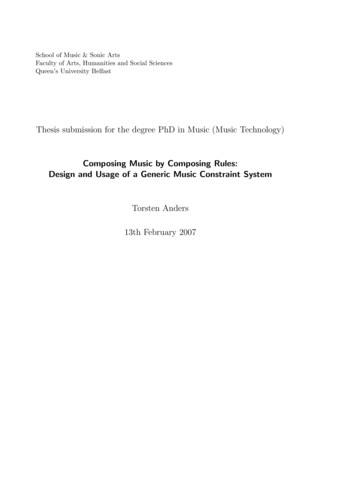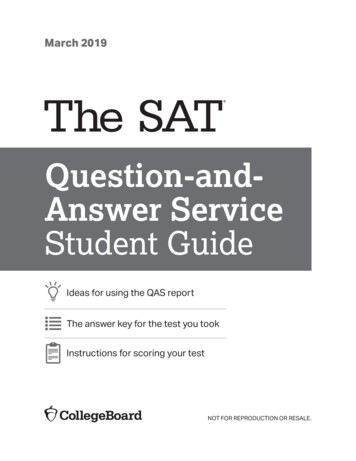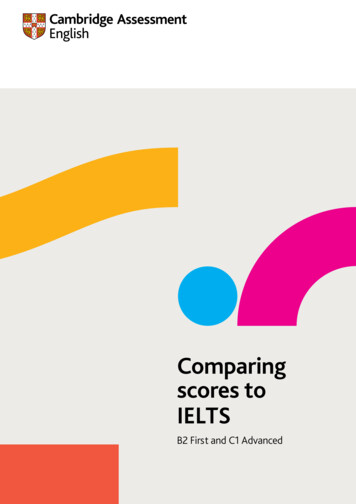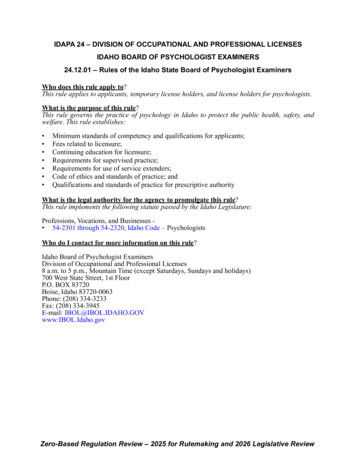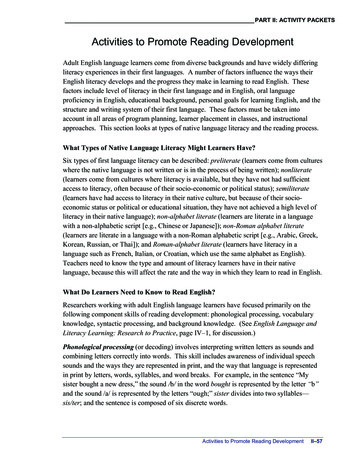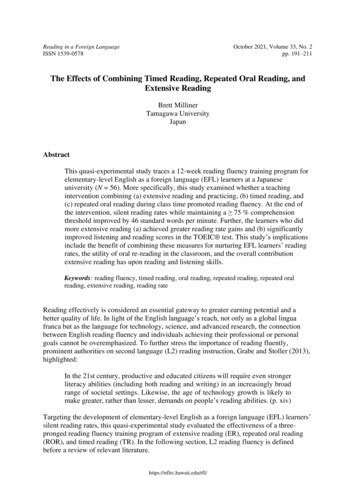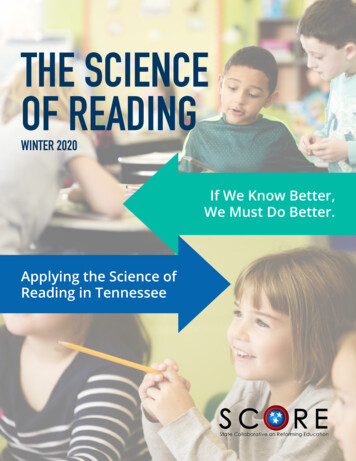
Transcription
THE SCIENCEOF READINGWINTER 2020If We Know Better,We Must Do Better.Applying the Science ofReading in Tennessee
There is a clear science to teaching reading.There is a clear science to teaching reading. Due to advancementsin cognitive science we know more about how kids learn to readthan ever before. The science of reading dispels misconceptionsand myths about reading instruction that have held students backfor decades.We have a responsibility to use the science of reading to informpolicy that fosters classroom practices aligned to the science ofreading. Only then will students experience reading instructionthat prepares them for citizenship beyond K-12.This resource lays out problematic misconceptions about readinginstruction and shares critical research headlines we should use toinform decisions. It offers suggestions to carve a path forward thatleads to the end of the reading crisis in Tennessee.The Science of Reading“RESEARCH IS THE ONLY TOOL WE HAVETHAT ALLOWS US TO DETERMINE THEKINDS OF TEACHING MOST LIKELY TOADVANCE OUR STUDENTS’ LEARNING;COMMONSENSE AND PAST EXPERIENCEARE USELESS BEFORE SUCH QUESTIONS.”TIMOTHY SHANAHAN2
Literacy rates in the US have beenrelatively flat for decades.According to the National Assessment of Educational Progress(NAEP), our country’s most representative and longest-standingassessment of what US students know and can do in coresubject areas, fourth- and eighth-grade students have shownonly modest increases in reading achievement since 1992. 35 percent of fourth-graders nation-wide performed ator above proficiency in reading in 2019 compared to 29percent in 1992. Eighth-graders have shown slower growth in achievement(proficient or above), improving from 29 percent in 1992 to34 percent in 2019. In 2019, the average reading scores for both fourth-gradersand eighth-graders were lower compared to the 2017assessment (2 percent and 3 percent lower, respectively). Twelfth grade reading proficiency is on a decline, nationally.In 1992, 40 percent of high school seniors were proficientor above in reading, compared to 37 percent in 2015. (NAEPdid not test twelfth-graders in 2017 or 2019.)We have areading crisisin Tennessee.The 2019 NAEP results highlight the stark disparities in readingachievement for many student subgroups. In fourth and eighth grades, Black, Hispanic, AmericanIndian/Native Alaskan, and Native Hawaiian/Other PacificIslander reading achievement is hovering at the Basic level.None of the groups had an average reading score in theProficient range. The same low performance trends hold true for studentswho qualify for free/reduced lunch, have disabilities, or areEnglish Language Learners.Literacy rates in Tennessee are no betterthan the national average.In 2019, 35 percent of fourth-graders and 33 percent ofeighth-graders performed at or above proficient on theNAEP reading assessment. Tennessee student achievement data show that an averageof 32.8 percent of students across grade levels are meetinggrade level expectations in English Language Arts. (TN DOE,2018) Only 13 districts state-wide have ACT results that meet thecollege-ready benchmarks for both English and Reading(The ACT college-ready benchmarks for English and Readingare 18 and 22, respectively.)The Science of Reading 3
The human brain is not naturally wired to read. Reading is acomplex set of skills that must be explicitly taught.A widely-held misconception is that learning to read is a natural process – much likelearning to speak- and that kids will naturally pick up the skills if given enough timeand access to text at their “just right” reading level. This is not true.“The Science of ReadingTHE IDEA THATLEARNING TOREAD IS JUSTLIKE LEARNINGTO SPEAK ISACCEPTED BY NORESPONSIBLELINGUIST,PSYCHOLOGIST,OR COGNITIVESCIENTIST INTHE RESEARCHCOMMUNITY.”KEITH STANOVICH4We are all born with the ability to processoral language.Humans are born with areas of the brain that are dedicated to orallanguage development. We are born to speak and use speech toconnect with others and make sense of the world around us.We are also all born with the ability toprocess visual images.We have a visual system in our brains that helps us make sense ofthe things we see, including written words.But we are NOT born with connectionsbetween those parts of the brain.Reading instruction must build the bridge between the orallanguage and visual image processing. We must train ourbrains to translate the shapes we see on a page (words) intomeaningful information. We make meaning by connecting thevisual information to the knowledge and vocabulary we have builtthrough oral language and life experiences.
Reading requires a complex set of mental processes.Effective reading instruction requires teaching of two types of competencies:foundational reading skills and knowledge-based competencies. Skilled readershave both solid foundational reading skills that allow them to translate writtenwords to spoken language and the ability to make meaning from what they read.Foundational Reading Skills—often referredto collectively as decoding—help early readersunderstand how letters, sounds, and wordswork. Foundational reading skills are finite andcan be fully mastered. They include things like: Concepts of print: Readers learn how toapproach a text and can read left to rightand top to bottom on a page. Phonemic awareness: Students learn tohear, identify, and manipulate individualsounds (phonemes) in words. For example,a kindergartener can identify the threesounds in the word cat: /k/ /a/ /t/. She canalso identify how the word changes if the /k/sound is replaced with /m/. Phonological awareness: Students learn tohear, identify, and manipulate units of orallanguage, including words, syllables, andother word parts. For example, a secondgrader can clap twice to show he canaccurately identify the number of syllableshe hears in the word “sister”: sis-ter. He cantap three times to count the syllables in“artichoke”: ar-ti-choke.Phonics: Readers learn the predictablerelationships between sounds (phonemes)and the letters and spellings that representthose sounds in written language. Withphonics, students have a system forremembering how to read and write words.For example, once a child learns that boneis spelled b-o-n-e rather than b-o-a-n, hermemory will help her read and spell theword instantly and more accurately inthe future. Spelling: Students use their knowledge ofphonics to accurately write the letters torepresent the sounds they hear in words. Fluency: Readers learn to read textaccurately, quickly, and with appropriateexpression to show they understandemphasis and tone. Fluency is the linkbetween decoding and comprehension. Vocabulary: Readers have vast knowledge ofwords and their meanings. Background knowledge: Readersaccumulate knowledge of the world,facts, and skills to build their backgroundknowledge. They use this backgroundknowledge to make sense of the informationthey come across through reading. Oral language skills: Students developcommand over word form, sentencestructure, and discourse. They can makemeaning from spoken language usingtheir background knowledge, vocabulary,and understanding of how language isstructured. Reading comprehension skills: Readerslearn to unlock the meaning of text becausethey can decode the words on the page andsimultaneously understand the meaning ofthose words.The Science of Reading Knowledge-based competencies are rootedin overall language comprehension and helpstudents create meaning from text. They aredynamic and are developed over a reader’slifetime, starting at birth. Knowledge-basedcompetencies include things like:5
Since 1986, reading expertshave used these twocategories of competenciesto clarify the relationshipsbetween decoding andlanguage comprehensionin reading, and elevate thecritical role skills-basedcompetencies have in readingability, particularly for earlyreaders.Both decoding skills andlanguage comprehensionabilities are critical, and bothmust be strong for proficientreading comprehension.Strength in one area cannotcompensate for a deficit inthe other area, particularlyfor young readers. In otherwords, a young reader withexcellent decoding skills willnot understand a text if shedoes not also have knowledgeof the topic. The opposite isalso true. A beginning readerwith a great deal of knowledgeof the topic will struggle tounderstand the text if hecannot read the words on thepage.Skills competencies must beautomatic; knowledge competenciesmust be applied strategically, as thereading rope model emphasizes.Tennessee schools must give attentionto both sets of competencies todevelop skilled readers.The Science of ReadingReading Rope image courtesy of the author, Hollis Scarborough.6
Foundational reading skills must be taught explicitly andsystematically.Some educators have the misconception that teaching phonemic awareness isneither necessary nor beneficial to learning to read. Others have the misguidednotion that phonics is beneficial only for struggling readers or students withdyslexia.The National Reading Panel evaluated existing research andevidence to find the best ways of teaching children to read. ThePanel considered roughly 100,000 reading studies published since1966, and another 10,000 published before that time. The NationalReading Panel’s analysis made it clear that the best approach toearly reading instruction is one that incorporates: Explicit instruction in phonemic awareness Systematic phonics instruction Methods to improve fluencyPhonemic awareness is essential to reading.Regarding phonemic awareness, the National Reading Panelconfirmed that:Explicit: pre-determined skillsare taught directlySystematic: skills are taught ina logical progressionThe 14-member NationalReading Panel includedschool leaders, teachers, andreading researchers. Phonemic awareness can be taught. Children learn to hear,think about, and work with the sounds they hear in words.Donald N. Langenberg, Ph.D.(chair) Phonemic awareness is required for reading. It enableschildren to read words rapidly and accurately, freeing up brainspace for comprehension.Gloria Correro, Ed.D. Phonemic awareness helps children learn to spell. Studentslearn to connect sounds to letters in predictable patterns.Gwenette Ferguson, M.Ed.Linnea Ehri, Ph.D.Norma Garza, C.P.A.Michael L. Kamil, Ph.D.The Science of ReadingCora Bagley Marrett, Ph.D.S.J. Samuels, Ed.D.Timothy Shanahan, Ph.D.Sally E. Shaywitz, M.D.Thomas Trabasso, Ph.D.Joanna Williams, Ph.D.Dale Willows, Ph.D.Joanne Yatvin, Ph.D.7
Case closed: Phonics instruction matters—a lot.When it comes to phonics instruction, the report of the NationalReading Panel closed the case on any lingering questions aboutthe benefits of phonics instruction. First, the research confirmswhat may seem obvious: for students to understand what theyread, they must first read the words on the page. The researchalso clearly found that: Students who receive explicit phonics instruction becomebetter readers than students who do not receive phonicsinstruction, or who receive spotty phonics instruction. Themost effective phonics instruction is systemic; it teachesa clearly defined sequence of the major sound-spellingrelationships of consonants and vowels. Effective phonicsinstruction is also explicit; the teacher provides precise anddirect instruction. Systematic phonics instruction has the greatest benefitswhen it begins in kindergarten or first grade. Systematic phonics instruction improves readingcomprehension, as the ability to read words accurately andquickly is correlated to reading comprehension. All students, regardless of their backgrounds, make greatergains in their reading when they receive systematic phonicsinstruction. Even students who learn phonics quickly andeasily gain vocabulary, increase their reading fluency and buildcritical thinking skills when they receive systematic phonicsinstruction.The abundance of research examined by the National ReadingPanel is bolstered by the findings of the National Assessmentof Educational Progress (NELP). NELP confirms that alphabetknowledge, oral language, and phonological awareness providethe basis for reading success.“But I didn’t have phonics instruction, and Ican read just fine!”The Science of ReadingIf this thought crossed your mind, you are likely a rare exception tothe rule.8 A very small minority of students—only 5 percent—learn toread effortlessly and with minimal phonics-based instruction. Another 35 percent of students learn to read easily and at arapid pace with explicit, systematic phonics-based readinginstruction. 40-50 percent of students require support through explicit andsystematic phonics-based instruction. This group representsthe average learner who can meet grade-level expectationswhen provided effective reading instruction. 10-15 percent of the population have symptoms of dyslexiaand require explicit and systematic phonics-based instruction,with intensive intervention and many repetitions.
Some worry that phonicsinstruction may harm thereading progress of studentswho can learn to readwithout it.The opposite is true:Phonics instruction benefitsall students regardless oftheir skill level. Providingsystematic, Tier 1 phonicsinstruction to all studentsproduces overall strongreaders, ensuring thatstudents are not left withgaps in their letter-soundknowledge. Phonics not onlysupports decoding and fluencyskills; it also boosts readingcomprehension, becausereading words accurately andautomatically allows readersto focus on the meaning oftext. Phonics instruction canbe differentiated for studentneeds and is best done inflexible groups to matchstudents’ needs and the paceof learning.Fluency is the bridgebetween decodingand comprehension. Students learn grade-level skills in thefoundational skills portion of their literacyblock. Lessons match grade-level standardsand are from a systematic scope andsequence, which is outlined in a researchbased, high-quality curriculum that buildsskills coherently from grade-level tograde-level. Students have fun while they learn. Instructionis engaging, child-friendly andage-appropriate. Students learn the correct way to pronouncesounds and words. The teacher’s instruction isaccurate and clear. Students practice hearing, saying, reading, andwriting their new skills. Lessons provide ampletime to practice decoding skills. Quick learners can go fast and those who needmore time get more practice. The teacherhas data on students’ learning progress anddifferentiates lessons.More details from Achieve the Core (PDF).The Science of ReadingFluent readers read withaccuracy, automaticity, andexpression. They immediatelyrecognize words and cancluster words into meaningfulphrases. Fluent readersdecode without much effort,allowing them to dedicateenergy to making meaningfrom what they read.What does explicit, systematicfoundational skills instruction look likefor students?9
Foundational reading skills can’t stand alone.Students also need background knowledge andvocabulary to be skilled readers.Some falsely believe that children must first learn to read before they can read tolearn. Others assume that building knowledge is not developmentally appropriatefor our youngest learners or that young students or students who are far behindare not capable of learning complex content or ideas.Of course, children must learn to read.We know from the vast body of research that children must learnto read, that is, they must learn to crack the code of English to beable to translate written words into spoken language. Teachingchildren to read means teaching foundational reading skills:phonemic awareness, phonics, and fluency.While foundational reading skills are best taught in kindergartenand first grade, we cannot wait until children are readingindependently to also teach knowledge. We must teach decodingskills and build knowledge and vocabulary, and we must startin the earliest grades. Even our youngest learners can buildknowledge about the world, even if they aren’t yet readingindependently.Learners of all ages are ready to buildknowledge and be exposed to complexideas.Child development is continuous and fluid; it does not happenin discrete stages as we once believed. This important discoveryshows us there is no single point in time that marks readiness tolearn and be exposed to new ideas.The Science of ReadingBuilding background knowledge is developmentally appropriate.As early as the 1960’s, cognitive scientists have shown thatexposing young students to complex ideas gives learnersappreciation and early understandings of those ideas. Children’sunderstanding might be incomplete at first, but over time and withmore experience, they will deepen and formalize their learning.10
“This does not mean our youngest learners should be expectedto build knowledge solely by reading on their own. Consider thebenefits of reading aloud to babies and toddlers: Teaches language structure Introduces new concepts and information Builds listening skills and language comprehension Teaches vocabularyThese same benefits carry into a child’s school years. In the earlygrades, teachers should read aloud content-rich texts that aretwo-three grade levels above their current grade to help studentsgrow their knowledge, vocabulary, and oral language skills.Research shows that from birth to about age 13, children’s orallanguage abilities exceed their reading comprehension abilities,meaning children learn more from listening to texts than they dowhen reading on their own. Read alouds are essential in the earlygrades to develop students’ listening comprehension, build theirknowledge of the world, and boost their academic vocabulary.The same best practices for building knowledge for young learnershold true for readers who may be far behind. Struggling learnersbenefit from building their background knowledge and vocabulary,and from growing their language comprehension skills. Knowledgeand vocabulary level the playing field for students who come toschool with language and experience gaps.The Science of Reading“TEACHERS CANREAD ALOUD TOBUILD STUDENTS’KNOWLEDGE OF THEWORLD BEYONDTHEIR SCOPE ANDTO HELP STUDENTSMAKE CONNECTIONSFROM THE KNOWNTO THE NEW.THERE IS LIKELYNO BETTER WAY TODRAW CHILDREN INTO THE TREASURESSTORED IN THEWRITTEN WORDTHAN THROUGHREADING ALOUD TOTHEM AS MUCH ASPOSSIBLE.”DAVID LIBEN11
Teaching knowledge and vocabularyimproves reading comprehension.Exposing students to new vocabulary, concepts, and backgroundknowledge grows students’ language comprehension, whichimproves both decoding and reading comprehension. For studentsto develop deep content knowledge and expertise that sticks,vocabulary and knowledge must be taught intentionally andsystematically by spending extended classroom time reading,listening to, and discussing multiple texts on the same topic.The texts must offer a rich diet of facts, ideas, and vocabularywords, and not be “trivial literature” or reading selections onfragmented topics.Vocabulary can make or break a reader’s success with a text: themore words a reader knows, the better her comprehension is.Readers become frustrated and struggle to comprehend when justtwo percent of the vocabulary is unfamiliar.The Science of ReadingHaving a solid base of knowledge of a topic helps readers takein new information as they read, solidifying and improvingcomprehension. Knowledge helps a reader fill in any blanksleft by authors and aids in making inferences. Knowledge alsohelps readers think about and internalize new information. Aswe read new information on a given topic, readers with existingbackground knowledge can more easily connect the newinformation with existing knowledge.12“MANY FACTORSCONTRIBUTE TOSUCCESSFULCOMPREHENSION–ACCURATE, FLUENTWORD READING,VOCABULARYKNOWLEDGE,AND THE USEOF STRATEGIESTO PREPARE TOREAD AND FIX UPMEANING WHEN ITBREAKS DOWN–BUTIN STUDIES THATHAVE EXAMINEDTHESE DIFFERENTCONTRIBUTIONS TOCOMPREHENSION,KNOWLEDGE IS THEMOST IMPORTANTCONTRIBUTOR.”CERVETTI & HIEBERT
The connections betweencontent knowledge andcomprehension are significant.In the famous “BaseballStudy,” researchers comparedthe relative impact of readingability to the impact ofknowledge of a topic. In thestudy, middle school studentswere grouped accordingto reading ability and theirknowledge of baseball.Students read a passage aboutbaseball and were then testedon their comprehension.The students with low readingability, but high knowledge ofbaseball outperformed thestudents with high readingability, but low knowledgeof baseball. Additionally, theresearchers found that therewas little difference betweenthe two high knowledgegroups and the two lowknowledge groups. The studyshowed that prior knowledgeof a topic has a greater impacton reading comprehensionthan general reading ability.Teachingknowledge is amatter of equity.Knowledge of the topic (baseball) had aMUCH bigger impact on comprehensionthan did generalized reading ability.79%69%47%35%High reading Low reading High reading Low readingability & high ability & high ability & low ability & lowknowledgeknowledgeknowledgeknowledgeThe WUG TestLow socioeconomic (SES) and Middle/High SESpreschool students listened to read aloudsabout four different species of birds in abook series. Then researchers tested readingcomprehension.Middle/High SES students outperformed low SESstudents when the topic was birds, likely becausethe higher SES students had more backgroundknowledge about birds.Next, researchers read a series of books on fourspecies of made up creatures called WUGS, atopic about which none of the students had priorknowledge.The Science of ReadingReading researchershave demonstrated thatbackground knowledgeequalizes the differences inthe effects of socio-economicstatus on language andreading comprehension.When we explicitly teach allstudents the same rich andmeaningful content, studentscan comprehend regardlessof their backgrounds andexperiences outside of school.The Baseball StudyWhen tested for reading comprehension onWUGS, students in both groups showed thesame level of comprehension.The Takeaway: If we level the playing field whenit comes to knowledge, we can close the gaps wesee in comprehension.13
Take action: Help students build theirskills-based competencies and theirknowledge-based competenciesStart in kindergarten.Literacy blocks must give time and attentionto both sets of competencies—those thatbuild decoding skills and those that buildknowledge—in grades K-2. Primary grades mustsystematically and explicitly teach students thedecoding skills required to crack the code of theEnglish language. Early readers need exposureto important background knowledge that theywill continue to build upon in later grades andthroughout life.Ensure students read and areread to—a lot.Students will develop as skilled readers onlywhen given the chance to grow their readingmuscles.Reading makes a person smarter; it builds“crystalized intelligence” (knowledge, facts, skills)and must be practiced regularly and frequently.The more one reads and is read to, the smarterone becomes. This is referred to as the MatthewEffect in reading. A high volume of readingincreases children’s decoding ability, wordknowledge, vocabulary, and comprehension.Additionally, as children become more skilledreaders, they enjoy reading more and are moremotivated to read, which in turn continues tohone their skills. The “rich” readers get “richer.”Provide the right kind and rightamount of reading strategyinstruction.It is a popular but misinformed beliefthat reading is a set of strategies thatcan be taught in isolation and thenapplied to any text.You may recognize how this commonmisconception plays out in the classroom: agroup of students meets with their teacherto learn a reading strategy, such as “compareand contrast.” Students practice “compare andcontrast” while they independently read booksat their desks. They spend weeks on a “compareand contrast” unit employing that strategy withdifferent texts.This type of strategy-based reading instructiondoes not benefit students. Rather, we can lookto science to better inform reading strategyinstruction: Reading strategy instruction is best taughtafter students are solid in their decodingskills, starting around third or fourth grade. Reading strategies are learned easily and donot require extensive teaching and practice. The handful of strategies that have themost positive impact on comprehension arethose that unlock the meaning of the text athand, such as making connections to priorknowledge, asking questions of the text,summarizing as one reads, and monitoringone’s own comprehension. A teacher’s time is best spent teachingvocabulary and knowledge.The Science of ReadingUnfortunately, the opposite is also true.Struggling readers tend to get less access totexts, particularly texts that are interesting andengaging, are less motivated to read, and havefewer opportunities to strengthen their readingskills. The “poor” readers get “poorer.”14
Use writing instruction as a toolto increase equity and boostreading comprehension.We must move away from themisinformed practice of teachingwriting separately from reading.Anchoring writing tasks and questions on thetext at hand evens the playing field for studentswho may have limited personal experiences todraw on. For example, reading about airplanesand then asking students to write about a timewhen they traveled in an airplane excludes anychild who has not had this experience.The Tennessee Academic Standards aredesigned to create equitable learningexperiences for all students. The standardsrequire that students have rich experienceswithin the text: building knowledge throughreading, using evidence in their writing thatcan only be found in the text, and learningacademic vocabulary found in those very texts.By grounding discussion and writing tasksin the text itself, all students are given equalopportunities to learn and engage. Reading andwriting become a shared experience in learningabout any topic.Approaching writing instruction in this wayalso boosts reading comprehension. Cognitivescience shows that we understand andremember the things we pay attention toand think about deeply. When students writeabout what they have learned from texts, usingspecific information and vocabulary, they betterunderstand and retain the new content.Eliminate practices that areineffective and inequitable.There are numerous programs and approachesthat are still used widely but are not based onthe science of reading. There is strong evidenceto show these approaches do not work.Whole language is a philosophy that assumesthat learning to read is a natural phenomenonand that if children are exposed to enoughtexts, they will develop a love of reading andthe skills needed to be fully literate. Wholelanguage is often charactertized by lessons thatencourage children to use context clues ratherthan decoding skills as the primary method ofword recognition. For example, if a line of text is“The Palomino was scarred,” a reader in a wholelanguage classroom may be encouraged to lookat the pictures or use context clues to guess atthe words, inaccurately making “The pony wasscared“ an acceptable response. Whole languageplaces emphasis on experiencing literacy overexplicitly building knowledge through rich textand systematic phonics instruction.Balanced literacy is deeply rooted in wholelanguage and claims to add phonics instruction.Most often though, phonics instructionfails to be added. If it is included, it is rarelyexplicit or systematic. Balanced literacy is notbalanced because it does not give adequatetime and attention to teaching the skills-basedcompetencies of reading that we know areessential to becoming a skilled reader.TIMOTHY SHANAHANThe Science of Reading“IT’S TIME THAT WE RETIRE‘BALANCED LITERACY,’FOCUSING LESS ONIDEOLOGICAL AND RHETORICALGAMESMANSHIP AND MOREON WHAT HAS BEEN FOUNDTO ACTUALLY HELP KIDS TOBECOME BETTER READERS.”15
Readers’ Workshop: A workshop approach has strongassociations with whole language and balanced literacy. Aworkshop typically includes a teacher-led mini lesson thatintroduces an isolated strategy (such as ‘finding the main idea’);time for students to independently practice the strategy inleveled text (meaning one the student can read independently);conference time with the teacher; some element of whole groupstudent sharing to give closure. The workshop approach isproblematic for two key reasons: first, students spend the bulk oftheir time reading texts that they can already read independently,eliminating opportunities to learn to navigate more complex textsand ideas. Second, students receive very little support for makingsense of text outside of one-on-one conferences with the teacher(on texts students don’t actually need support on to begin with).Guided reading is commonly used as time for teachers to workwith small groups of students who have similar reading behaviors,or who read on the same “level.” Teachers often use books that areon the students’ instructional reading level, referred to commonlyas ‘leveled readers’, so that students can read with minimalchallenge and can practice skills/strategies that the teacherintroduces. The practice of using leveled texts has been debunkedsince the 1960’s. Studies show that leveled texts can stunt thereading growth of students since the texts limit the opportunitiesstudents have to grow their reading skills. In fact, students growmore in their reading when they have opportunities to read (withsupport) texts that are at their “frustration” level – that is, texts thatare two-four grade levels above their instructional level. Studentsdo need teacher guidance and support, but that support is bestleveraged when students read texts that are rich and offer a lot ofopportunities to build their knowledge of the world.The Science of ReadingA whole language-based or “balanced” approach intensifiesthe inequities
There is a clear science to teaching reading. There is a clear science to teaching reading. Due to advancements in cognitive science we know more about how kids learn to read than ever before. The science of reading dispels misconceptions and myths about read
